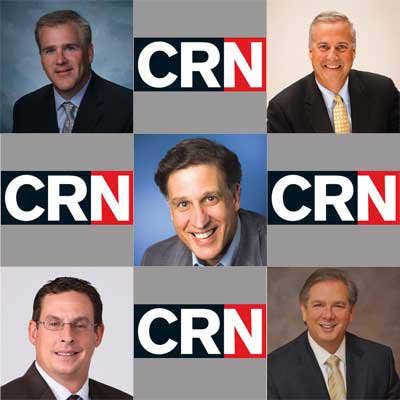Words Of Wisdom: 10 Hot Topics From CRN's Channel Chief Roundtable

Channel Chatter
CRN recently held a roundtable discussion with some of the top channel executives in the industry: HP's Scott Dunsire (top left), VMware's Frank Rauch (top right), Dell's Frank Vitagliano (center), Lenovo's Chris Frey (bottom left) and Cisco's Edison Peres (bottom right). The channel chiefs tackled a number of topics, from channel growth and partner recruitment to specialization and overdistribution. Here are some of the highlights from the conversation.

Channel Growth
Frank Rauch, vice president, Americas Partner Organization, VMware
We are seeing a little bit of a barbell model. We are seeing growth at the top and kind of growth at the bottom. The guys I would be worried about are more the guys in the middle, people that have lived off of five or 10 larger accounts and maybe don't really have the demand generation engine, But we are seeing that basically smaller companies in the SMB space still want to buy from very local buyers. We see that some mergers and acquisitions are happening. But the trick for us is really how do we service the breadth of partners and then how do we drive preference at some of the larger partners, and then basically how do we consult on new business models, whether it be cloud, mobility or BYOD, to be able to help them develop into those markets.

The Internet Of Everything
Edison Peres, senior vice president, worldwide channels, Cisco Systems
Cisco likes to use the term "the Internet of Everything." Today there are 2 billion people connected to the Internet and 20 billion devices. In the future, it's going to go to 5 billion people and 50 billion devices. So what is going to happen is that the world of all of those devices, the Internet of Everything, is going to change the portfolio of the partners. So if you are thinking about the old days, it was about bigger partners selling hardware and a little bit of services that went with it. In tomorrow's world, I think you are going to have some big partners, but you are also going to have a lot of new partners out there developing services, and capabilities, and the connections to applications that are going to be much more vertical and much more vertical solutions.

Financial Health Of Partners
Frank Vitagliano, vice president, channel sales, Dell
It ebbs and flows. It certainly has improved from 2008 and 2009, no question. But I would still tell you that there's a lot of partners, particularly in the tertiary markets, the regional kinds of guys that run a business on cash flow, that would make a lot of us nervous relative to the big issue there: They have a small number of core customers that they do a lot of business with, and they are absolutely the trusted adviser with that small number of big customers for them. And if a couple of them go south, which is what happened in the 2008 and 2009 time frame, they are hurting and they are hurting big time. That is the thing that I think is challenging to a lot partners.

BYOD Effect
Chris Frey, vice president, North American channels, SMB, Lenovo
The average user today will have 3.3 devices in 2014. That's what Gartner says. That's a lot of devices. Take that number and multiply it times the number of employees, and that's how many devices that they have to actually support versus what they had to five years ago or maybe even three years ago. The opportunity for them to gravitate into the cloud by starting at the entry point, which is a device -- which you can till the ground with because there are multiple flavors now between OSes and form factors and phones -- I think there is device confusion out there. Our partners are talking about bringing a cloud solution as it relates to being able to recommend devices that their customers want that they actually believe they can support. Then you tie that into the secure mechanism of the cloud and making sure that now those devices, 3.3 devices per employee, they've got to be secure.

Partner Recruitment
Scott Dunsire, vice president, general manager, Printing and Personal Systems Group and Americas Channels, Hewlett-Packard
To me it's not about the number of partners. It's about leveraging the ones we already have. I agree with you there will be partners that come into the game because they are going to develop a solution or a service where companies like HP will have the right mix, the right product set for them to go to market with, but when you look at the productivity with the partners that we already have today, we can be much more efficient than we are. I'm not out searching to recruit new partners. Now on the [HP Enterprise Group] side of the house, it could be a little different story but in the device business it is really more about trying to get better results from the partners that we do have, and that is how we decided to manage it.

Profit Margins
Dell's Frank Vitagliano
I think one of the biggest problems we have in the industry is overdistribution. This industry is driven by profit, no matter who you talk to, no matter how many discussions you have with business partners, whether they go back 30 years or where they are going to be 30 years in the future, it is all about profit. When you add and you have a proliferation of partners all going after the same space, what ends up happening is margins start to dissipate. Partners are making less money for the same amount of business that was out there. One of the things that I have been looking at is managing a partner ecosystem that ensures that partners can make money, and if you want to do that, it isn't about just going and adding a whole bunch of partners and just getting them to compete with each other so that they all make less money. We've got to be careful about that.

Narrow The Focus
VMware's Frank Rauch
I guess my advice to any partner would be really around sustainability. I think the tendency right now is to go after the bright and shiny object, and to be, you know, maybe it's big data one day, maybe it's cloud another day, maybe it's devices another day, etc. You need to be able to have a plan. You need to be able to monetize the plan, and you need to be able to sustain. I think the same thing can be said around line cards as well because again you have a number of companies that are starting to develop probably at a more rapid rate than we have seen over the last three or four years, and they are starting to appear. A lot of them are here, and you are starting to see new guys at these events, etc. I still think there is an opportunity with all of us to be able to minimize, to be able to consolidate the line card. If you consolidate the line card, then I think a lot of the financial risk and startup costs are mitigated to some degree by going with some of the vendors that have been around for a while.

Hardware Opportunities
Lenovo's Chris Frey
Granted, maybe there is not a lot of margin there [with devices]. So the margin dollars aren't significant. However, if you can keep somebody from getting into your customer's infrastructure or ecosystem with a device, then you scale up inside of that ecosystem. BYOD is not just a concern. It's an issue. From 2011 to 2012, most workers doubled the amount of their personal devices they brought, and it's expected to double again. You are almost getting to about 65 [percent] to 70 percent of actual employees inside of the company bringing their own device and being allowed to use them. You start getting down in these where the local VAR is talking to an SMB customer; I think there is a great opportunity to create a practice that starts with the device and can move up the scale, lock their competitors out, and then do these things that are different from the typical PC business that they may have been in. There's a scaling opportunity here, especially in the local environment for VARs.

Specialization
HP's Scott Dunsire
I think the advice that you need to give to partners is they have to have a specialization. The "peanut butter approach" I think is probably not the right strategy. You have to have a specialization, whether that is vertical markets, health care, public sector, manufacturing, something that gives you a one up, especially in the device side and the mobility side. I would recommend to partners that if they don't have that mobility practice established today, they better have it, because that is where everything is going.

Bigger Opportunities, Bigger Solution Providers
Cisco's Edison Peres
I think the next 10 years is going to be much more exciting than the last 10, and the last 10 was great. If you think about the last 30 years, every 10 years it's been more exciting with more to do and more potential for profit and more potential for growth. Ten years ago if we were talking about a $10 million field partner, that was a relatively nice, medium-sized partner. Now that is $100 million for us to get into that same realm. That was never the case years ago, and I think it's because there's much more to sell and more potential to add value.